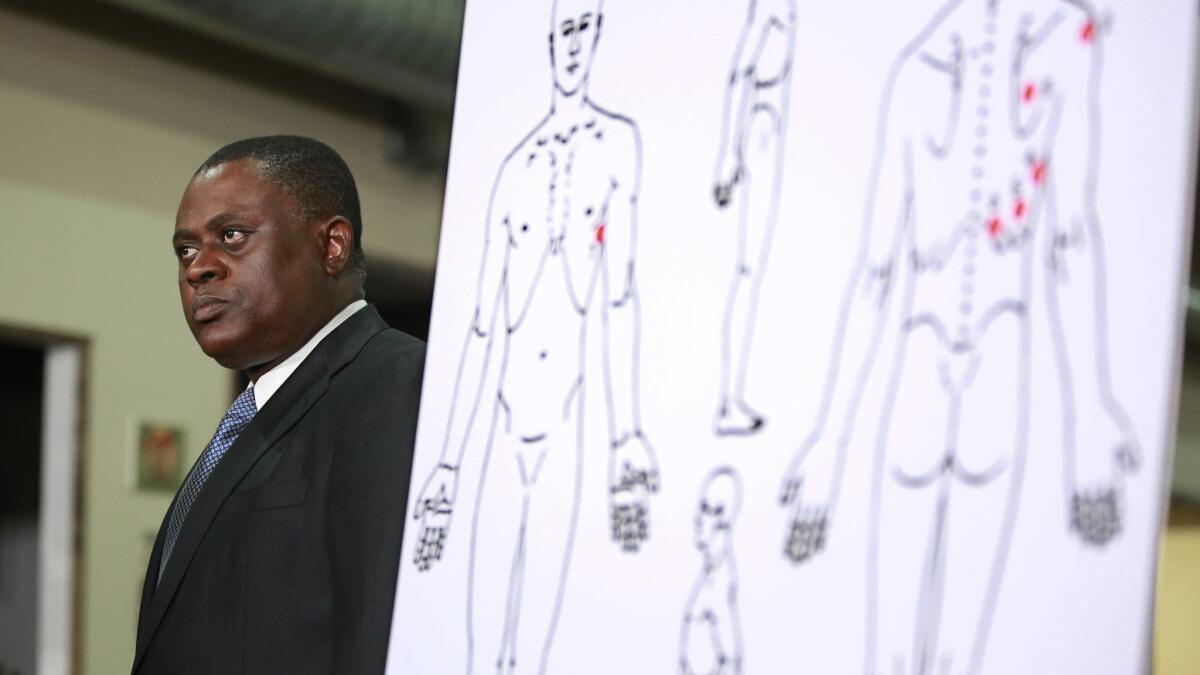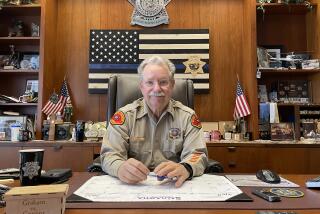Shot in the back: What the autopsy in the Stephon Clark killing says about officersâ actions

Reporting from sacramento â New revelations in the case of Stephon Clark, the unarmed African American man whose shooting by Sacramento police has generated controversy, raise new questions about the officersâ actions.
But how much do they changes our view of what happened?
An independent forensic pathologist hired by the family found that Clark was shot six times in the back.
Dr. Bennet Omalu conducted an autopsy, which said Clark was hit by eight bullets, and all but one entered while his back was turned toward police. One bullet entered Clarkâs left thigh from the front and was probably fired while he was on the ground and had already been shot multiple times, Omalu said.
From the beginning, there has been debate among police use-of-force experts about whether the officersâ actions were wrong, let alone criminal, as his family and supporters have said.
Here is how two law enforcement experts say the findings fit in:
Ed Obayashi: âItâs not surprisingâ
Ed Obayashi, legal advisor and sheriffâs deputy in Plumas County, said he believes the officersâ decision to shoot was reasonable based on the circumstances when confronting the young man in the backyard with an object in his hands that they perceived as a weapon and one officer yelled âgun.â
âThe shots in the back. They donât change my opinion at all. Under these physical circumstances, itâs not surprising he was shot in the back,â Obayashi said. âThis is a situation of two to 2½ seconds with multiple rounds being fired here and that time passes very fast.â
âThe human brain â the mind in these situations â cannot process quick enough to stop firing,â Obayashi said, so it is not uncommon to see those in confrontations with the police to be hit in the back. âThese officers arenât Wyatt Earp, and this isnât all Hollywood.â
Obayashi said the public should understand that it is as if a boxer throws a punch and misses because the opponent ducks. With firearms, it is even harder with targets moving constantly, so shots miss and eventually hit when the person swivels or changes direction.
He said the audio also suggests that officers still perceived Clark as a threat on the ground because they said, âDonât move, donât move.â In criminal terms, Obayashi said, it boils down to what would a reasonable officer do under these circumstances based on the information he or she possesses.
Seth Stoughton: âShooting after he is down on the groundâ
Seth Stoughton, a University of South Carolina law professor who studies shootings and was a Tallahassee, Fla., police officer, said âwatching the helicopter video, it seems the officers are shooting after he is down on the ground.â
Stoughton said that when combined with the video images the back shots suggest that the young man was likely down or had fallen to the ground when officers continued to fire.
âIf the police are justified in shooting someone, they can be justified in shooting on the ground. ⌠Just because someone is on the ground it does not mean they are not a threat,â he said.
However, Stoughton said, that assumes the officers or the public face a threat in this situation. âThe big question here is was the shooting justified at all. And I donât think the videos provide a clear answer one way or another.â
Stoughton said the videos show officers confront Clark, seemingly duck for cover and then confront him again by shouting about a gun. âThe question is how well did officers see Mr. Clark? Another question is whether officers who had some cover could have maintained their position of relative safety until they could assess the situation.â
Charles âSidâ Heal: âIs that reasonable?â
Retired Los Angeles County sheriffâs Cmdr. Charles âSidâ Heal also said the autopsy findings need to be looked at in a larger context.
âI am not surprised he was shot in the back ⌠he may have turned and ran,â Heal said, adding that the officersâ deadly shooting is âjust not pretty.â
In this case, he said, âthe officers made their decision based on circumstances. âIs that reasonable?â is the question. Once you are convinced the suspect has a weapon, you go into response mode. Self-preservation takes over. We try to train that out of people.â
Police: A narrative of the shooting
Clark, 22, was fatally shot in his grandmotherâs backyard on March 18 by Sacramento police, who were looking for a vandal in the neighborhood.
On Wednesday, a police spokesman said Clark remained the sole suspect in vehicle break-ins and what a sheriffâs deputy said was the attempted break-in of a home. It was a call about those incidents that sent police to the neighborhood the night Clark was shot.
A Sacramento County Sheriffâs Department helicopter spotted a man in a backyard and directed police toward him, authorities said. Deputies told officers that the man had picked up a âtoolbarâ and broken the window of a home.
The man was seen running south, toward the front of the house, where he stopped and looked into another car, police said. Police body camera footage shows that officers intercepted Clark in the backyard of his grandmotherâs house, and one of them yelled âgun!â as he turned a corner and saw Clark. The officer ducked momentarily, then looked around the corner again, shouted âGun! gun! gun!â and began rapid fire. His partner then joined the shooting.
The officers told other police who arrived on the scene they thought Clark was pointing something at them. âIt looked like a gun from our perspective,â an officer said.
The object found when they rolled over Clarkâs body was a white cellphone.
Clark was pronounced dead at the scene. Police video shows that several minutes passed until officers approached Clarkâs body. They then handcuffed him before appearing to attempt resuscitation.
Clark family: Autopsy contradicts police accounts
Clarkâs family has disputed police accounts of what led to the shooting, and denies that he was the man police were looking for.
The familyâs attorney said the autopsy adds to the questions.
âItâs very simple. The narrative thatâs been put forth is they had to open fire because he was charging toward them,â said civil rights litigator Ben Crump, who is representing Clarkâs family. Yet the autopsy shows, Crump said, âall of the bullets were from behind.â
Omalu said it appeared that the coroner did not seek to determine the pathway of the bullets, which is key to determining the sequence.
A âclusterâ of bullets that entered Clarkâs back decimated his body, each carrying âfatal capacity,â Omalu said.
One round fractured Clarkâs right arm, shattering a section of bone that completely lacerated all the blood vessels around the wound, he said. Another cut through Clarkâs flesh and hit his spinal cord, where it caused massive bleeding.
A round went under Clarkâs rib, piercing his lung and caused massive bleeding in his chest, Omalu said. Another injured his aorta.
The combination of trauma, bleeding and a punctured lung would have cut off oxygen to Clarkâs brain but he did not die instantly, Omalu said. It took several minutes, he said.
Omalu was brought in by lawyers for Clarkâs family in preparation for a planned federal lawsuit against the city and its police officers. He resigned last year as chief forensic pathologist in neighboring San Joaquin County, citing allegations that the sheriff sought to sway findings to protect officers responsible for fatal shootings. Others in Omaluâs office also quit, but the sheriff denied the allegations.
St. John reported from Sacramento, Winton and Serna from Los Angeles.
[email protected] | Twitter: @LAcrimes
[email protected] | Twitter: @paigestjohn
[email protected] | Twitter: @JosephSerna
UPDATES:
7 a.m., March 31: This article was updated with comments from retired Los Angeles County sheriffâs Cmdr. Charles âSidâ Heal.
This article was originally published at 3:25 p.m., March 30.
More to Read
Sign up for Essential California
The most important California stories and recommendations in your inbox every morning.
You may occasionally receive promotional content from the Los Angeles Times.













